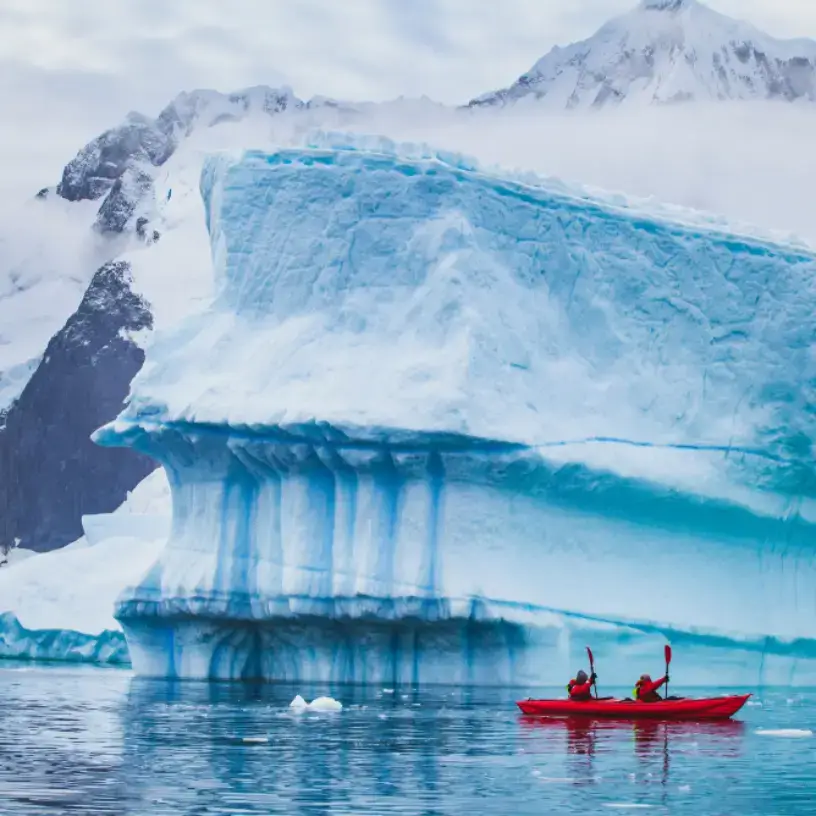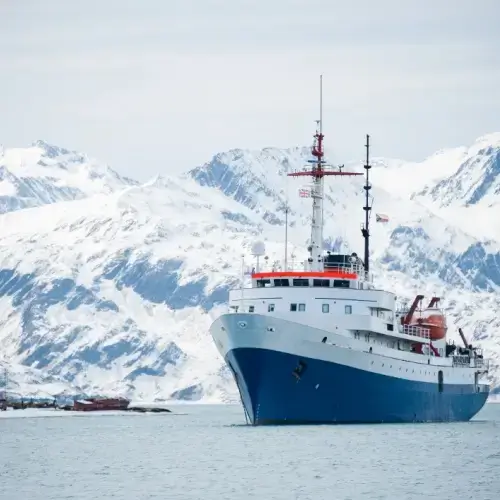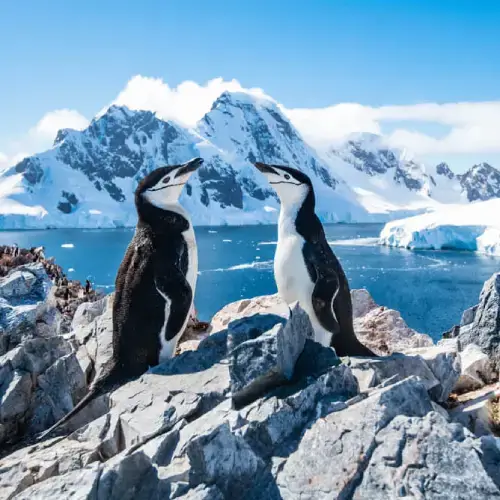Home / Compare Travel Insurance / Travel insurance for Ant…

Key takeaways
- Antarctica may not be covered by some insurers, so it’s important to compare policies to find one that matches your needs.
- If you’re travelling to Antarctica from South America or another destination, make sure your policy covers each place you’re visiting, as well as any activities you plan to participate in.
- Check your policy inclusions and exclusions as you may need to purchase ski or adventure cover as an optional extra to be covered for activities such as off-piste skiing, glacier walking and kayaking.
Do I need travel insurance for Antarctica?
Antarctica is very remote, so medical attention and evacuation can be extremely expensive if you don’t have adequate cover to protect you. Because of this, it’s unlikely that you’ll find a responsible tour operator who doesn’t insist that you get travel insurance.
While travel insurance isn’t mandatory for all cruises, there are some that may deny boarding if you don’t have an adequate level of coverage. The necessary level of travel insurance coverage may vary depending on your tour operator and your individual circumstances and needs.
Expert tips for choosing the right travel insurance for Antarctica
Our Executive General Manager of General Insurance, Adrian Taylor, has a few tips on getting the most out of your travel insurance policy for Antarctica.

Make sure your insurer covers Antarctica
Some insurers may not cover losses in Antarctica, so check the coverage, terms and conditions of a policy before making any purchase. You may want to contact an insurer directly to ask about coverage for Antarctica. If you’re heading to South America to depart on a cruise from Ushuaia, Argentina or Punta Arenas, Chile, don’t forget to also list these or any other destinations on your travel insurance policy.
Consider what you need cover for
For such a remote destination, it’s crucial you’re covered for emergency medical evacuation and medical treatment, as transportation back to a country with the healthcare you need can be incredibly expensive. You should also consider cover for disruptions such as cancellations and luggage, as well as any additional cover you may need for cruise or ski holidays. You’ll need to buy a policy that suits all the requirements of your trip.
Consider increasing your excess to lower your premium
You might want to choose a higher excess to reduce your premium. But remember that your excess is what you pay out of pocket if you need to make a claim, so always choose a manageable excess amount.
What you should know about travelling to Antarctica
Why should I get travel insurance for Antarctica?

Certain risks come with going to the most isolated continent in the world where there are more icebergs and penguin colonies than people.
Things can go wrong on any holiday, so taking out travel insurance can help you prepare for unexpected events that may cause you financial loss. Without travel insurance, you may be left out of pocket for these expenses; however, not all travel insurers will provide cover for trips to Antarctica, so you’ll need to research thoroughly before you purchase any cover.
The full list of inclusions in your policy can be found in your Product Disclosure Statement (PDS). You should also read the Target Market Determination (TMD) to help ensure your policy suits your circumstances.
How do I get to Antarctica?
There are two ways to see Antarctica: by plane or by cruise.
Those hoping to avoid the infamous Drake Passage may be interested in a scenic flight. You should ensure you have cover for cancellations and flight delays in case of bad weather disrupting your travel plans.
However, cruises are the more immersive option, with each voyage offering various activities and stops, with itineraries potentially including brief trips to the Falkland Islands and South Georgia on your way to the Antarctic Peninsula. You’ll likely need to purchase cruise cover as an add-on to be sure you’re covered if you visit Antarctica by sea.
Either way, you should consider a comprehensive policy to ensure you, your belongings and your trip are covered in the event something goes wrong.
Is Antarctica safe?
While there’s a community of scientists who live in Antarctica depending on the season, there are no permanent residents, towns, cities or commercial industries.
While it can be very safe if you go with a guide, Antarctica is still the coldest place on earth. In fact, temperatures in Antarctica can go below -80 degrees Celsius in winter.1 Extreme cold can put travellers at risk for hypothermia and frostbite.2
Antarctic operators may provide you with some safety equipment, such as proper boots and warm jackets. However, you shouldn’t rely on just this. Check your tour operator’s recommended packing list and make sure you bring your own warm, snow-appropriate clothing. You should also take care to keep any gear and camera equipment warm as the extreme cold can freeze expensive equipment.
While severe weather can delay cruises, they’ll still travel in moderate weather conditions. The journey from Australia to Antarctica can involve rough seas – particularly through the Drake Passage – which can put travellers at risk for seasickness. If you’re prone to travel illness, make sure you bring seasickness pills prescribed by your doctor.
What should my travel insurance for Antarctica include?
Antarctica is a unique destination that offers the ultimate adventure. A great way to start preparing for any destination (not just Antarctica) is with a comprehensive travel insurance plan, and here’s why.
Medical cover
Tours to Antarctica may require passengers to have international travel insurance that covers emergency evacuation, medical expenses, hospitalisation and emergency repatriation.
You can normally get covered for all of these with comprehensive travel insurance, but always check your product’s PDS before purchasing.
Cruise ships may have basic medical care, but any serious injuries that require emergency evacuation to the nearest country can potentially cost you thousands. Travel insurance can help cover these costs.
Cruise cover

Most travel insurance policies don’t automatically include cruise cover. So, if you purchase travel insurance without including cruise cover as an optional add-on, you may not be covered for losses relating to the cruise.
An adequate insurance policy can protect you financially when things don’t go as planned. This is especially useful for Antarctica cruises, which are some of the more expensive cruise trips a traveller can take due to the remote location, expensive transportation and limited trip availability. Cruise cover can provide insurance for:
- Overseas medical and hospital expenses
- Medical evacuation coverage
- Cabin confinement due to sickness
- Cancellation costs for pre-paid travel arrangements
- Trip delays and rescheduling fees
- Missed cruise departure
- Missed pre-paid shore excursions
- Lost, stolen or damaged luggage or personal belongings
- Additional expenses
- 24-hour emergency assistance.
Remember to always read the policy’s PDS to know exactly what you’re covered for before purchasing.
Adventure sports cover
Unless you plan to stay inside the cruise ship for your entire Antarctica trip, you may also want to get adventure sports cover. This product will let you participate in a range of adventure sports with the safety of knowing that you’re covered if anything goes wrong.
Some sports that this type of policy covers may include, but aren’t limited to:
- Glacier walking
- Kayaking
- Trekking
- Ice fishing.
Check your policy’s PDS for more details on what type of activities you’re covered for.
Winter sports cover
For adventurous skiers, Antarctica is an ideal destination to test their skills. However, ski trips aren’t generally included in cruises and usually involve flying directly to Antarctica for a skiing expedition. If this interests you, or you plan on taking part in other snow activities, you should consider ski and snowboarding cover in case of an accident or unexpected event.
However, it’s important to understand that not all insurers will cover ski touring (skiing on un-marked trails), as some winter sports cover is limited to “on-piste” (on a marked path) activities, so keep this in mind when comparing policies. Some insurers may cover off-piste activities as long as you declare you won’t be on marked trails.
Ideally, your cover should include:
- Emergency medical evacuation
- Medical treatment and hospital expenses if you’re injured on your trip
- Protection for your ski equipment against damage, loss or theft.
While you should always check your policy’s PDS, this is especially important when travelling to uncommon destinations and participating in high-risk activities. Before purchasing your cover, you should read the policy’s terms and conditions, provisions and exclusions to understand if you’re covered for everything you need.
Luggage cover
If someone steals your cash, damages your belongings or your luggage is delayed in arriving, this feature may cover some or all of the expenses that come with these scenarios.
Be mindful that you won’t be covered if your belongings were stolen while unattended, as you didn’t appropriately protect your possessions. You also won’t be covered if a third party (like your airline or tour operator) compensates you for the loss, delay or damage.
Trip cancellations, disruptions and delays
Cancellation and delay cover will usually be included in cruise cover. This type of cover is crucial as Antarctic cruises are often delayed due to severe weather.
Outdoor activities like kayaking, camping or exploring glaciers may be cancelled last minute. If you’ve missed out on a pre-paid shore excursion or have a non-refundable deposit for an activity, your travel insurance may compensate you for those costs (if the cruise line hasn’t already reimbursed you).
What is excluded from travel insurance for Antarctica?
All travel insurance policies have specific exclusions that may limit their cover. These will vary depending on your insurance provider and policy, but in general, some common exclusions may include:
- If you didn’t disclose any pre-existing medical conditions. You may not be covered if you try to claim because of an incident related to a pre-existing medical condition that you didn’t disclose or that your insurer didn’t agree to cover.
- If you leave your belongings unattended. Your belongings will only be covered if you took the necessary precautions to keep them safe.
- If you go against the advice of your activity guide. If you ignore your cruise or activity guide’s advice, your insurer may not cover you in the event of an accident.
- If you were intoxicated when you were injured. Drug or alcohol-related injuries usually aren’t covered.
Find out more about what’s not typically covered by travel insurance policies by visiting our page on common travel exclusions. Your policy’s PDS will specify any exclusions applicable to your cover.
Meet our travel insurance expert, Adrian Taylor
As a General Insurance expert with over 13 years’ experience in financial services, Adrian Taylor believes in educating customers about the importance of travel insurance so that anyone can kick back and make the most of their time away from home. While no one wants a disrupted holiday, a suitable travel insurance policy can provide a financial safety net for yourself, your belongings and your trip in case things go wrong.
Want to know more about travel insurance?
1 Australian Antarctic Program – Department of Climate Change, Energy, the Environment and Water, Australian Government. Antarctic weather. Accessed May 2024.
2 Smartraveller. Severe weather. Last updated October 2023. Accessed May 2024.


